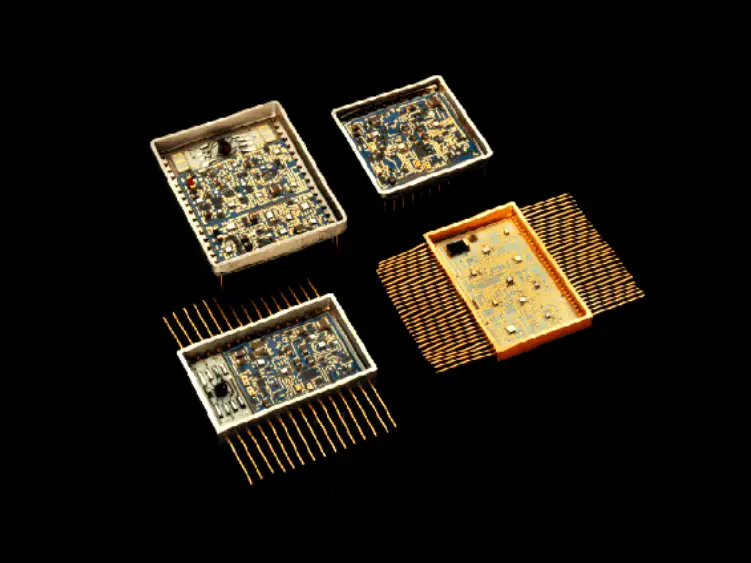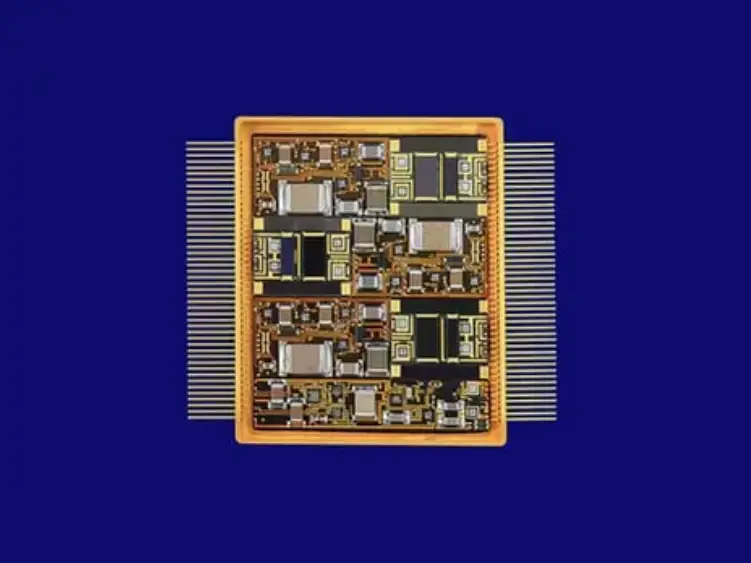Hybrid Integrated Circuit: Combining Technologies for Powerful Electronics
Unleash the combined power of discrete components and integrated circuits! Explore hybrid integrated circuits (HICs) for your next project. HICs offer superior performance, reliability, and miniaturization in demanding applications like aerospace, medicine, and telecommunications. Discover the possibilities – Get our free HIC samples today!
Hybrid Integrated Circuit

Stuck between bulky discrete components and limitations of ICs? Hybrid integrated circuits (HICs) offer the best of both worlds! Get superior performance, unmatched reliability, and compact size for your demanding applications. Learn more about HICs now!

Hybrid Integrated Circuit Fabrication
Want to push the boundaries of electronic design? Master hybrid integrated circuit (HIC) fabrication! This advanced technique combines the best of discrete components and ICs for unmatched performance. Learn the skills to create powerful, miniaturized electronics for demanding applications. Start your journey today – download our free HIC fabrication guide!
Hybrid Silicon Photonic Integrated Circuit Technology
Hybrid silicon photonic integrated circuits (HICs) are a specific type of HIC designed to combine the strengths of silicon photonics and traditional electronics.
Here’s a breakdown:
- Silicon Photonics: This field focuses on using silicon to manipulate light for applications like optical communication and sensing. Silicon is a mature and cost-effective platform for electronics, making it attractive for photonic integration.
- Hybrid Approach: In hybrid silicon photonic ICs, components for manipulating light (like waveguides, modulators, and detectors) are integrated onto a silicon chip alongside traditional electronic components (transistors, resistors, capacitors).
Here are some key benefits of this technology:
- Economies of Scale: Silicon is a widely used material in electronics, leading to established and cost-effective fabrication processes. This translates to potentially lower costs compared to other photonic integration platforms.
- High-Density Integration: Silicon allows for miniaturization of photonic components, enabling complex optical circuits on a single chip.
- Leveraging CMOS Compatibility: Many photonic components in HICs can be fabricated using processes compatible with standard CMOS (Complementary Metal-Oxide-Semiconductor) technology, further reducing costs and complexity.
- Maturing Technology: Hybrid silicon photonics is a rapidly evolving field with ongoing research to improve performance and functionality.
However, there are also some challenges associated with this technology:
- Limited Functionality: While silicon is good for some photonic components, it doesn’t offer the same level of performance as some other materials for light generation and manipulation.
- Integration Complexities: Integrating photonic and electronic components requires careful design and fabrication processes to minimize crosstalk and ensure optimal performance.
Overall, hybrid silicon photonic integrated circuits offer a promising approach for building compact, cost-effective, and high-performance optical devices for various applications, including:
- Optical Communication: HICs can be used to create integrated transceivers for data transmission in data centers and communication networks.
- Biomedical Sensing: Photonic components can be integrated with electronic circuits for miniaturized biosensors used in medical diagnostics.
- High-Performance Computing: On-chip optical interconnects within HICs could enable faster data transfer within computer systems.
As research progresses, hybrid silicon photonics is expected to play an increasingly important role in the future of integrated optics and its diverse applications.
Hybrid Integrated Circuit Applications
Microwave Circuits
HICs excel here due to superior performance of their passive components (inductors & capacitors) at high frequencies, making them ideal for microwave amplifiers, filters and mixers in radar systems, communication equipment and satellite technology.
RF (Radio Frequency) Applications
Similar to microwave circuits, HICs find use in RF amplifiers, mixers and filters due to their high-quality passive components. This translates to better functioning radios, cell phones and Bluetooth devices by enabling efficient signal transmission and reception.
Power Electronics
HICs can handle high voltages and currents, allowing them to integrate power devices like transistors and diodes for efficient power management in DC-DC converters, inverters and motor drivers used in power supplies, solar energy systems and electric vehicles.
Specialized Circuits
HICs are not limited to the above and can be found in various other applications where specific functionalities are required. Their ability to combine different components makes them suitable for custom designs.
Hybrid Integrated Circuit Applications
What is hybrid integrated circuit
A hybrid integrated circuit (HIC), also called a hybrid microcircuit or simply hybrid, is a miniaturized electronic circuit that combines different electronic components on a single platform.
why choose hybrid integrated circuit
There are several reasons why you might choose a hybrid integrated circuit (HIC) over other options like monolithic integrated circuits (ICs) or discrete components:
Specific Functionalities:
- Wider component selection: HICs allow you to integrate components that can’t be easily fabricated using traditional IC processes. This includes high-value capacitors, large inductors, transformers, and certain types of resistors with precise tolerances. These components might be essential for your circuit’s functionality.
- Customizable designs: Due to the use of pre-made components, HICs offer more flexibility in design compared to monolithic ICs. You can choose specific components based on your needs, potentially leading to better performance in niche applications.
Performance Advantages:
- High-frequency performance: In some cases, the discrete components used in HICs can offer better performance at high frequencies compared to miniaturized versions found in monolithic ICs. This makes them ideal for applications like microwave circuits, radio frequency (RF) amplifiers, and filters.
- Power handling: HICs can be designed to handle high voltages and currents more effectively than monolithic ICs. This is because they can integrate power devices like transistors and diodes alongside passive components, making them suitable for power electronics applications like DC-DC converters, inverters, and motor drivers.
Other Considerations:
- Cost-effective for small batch production: For low-volume production runs, HICs can sometimes be more cost-effective than developing a custom monolithic IC due to the simpler manufacturing process.
However, it’s important to remember that HICs also have some drawbacks:
- Larger size and weight: HICs tend to be larger and heavier compared to monolithic ICs with similar functionality due to the use of discrete components.
- Potentially higher cost for large production runs: For high-volume production, the cost advantages of HICs might disappear, and monolithic ICs might become more economical.
- Limited frequency response: The additional connections and components in HICs can introduce parasitic elements that limit their performance at very high frequencies compared to monolithic ICs.
Choosing an HIC depends on your specific application’s needs. If you require functionalities not achievable with monolithic ICs, need superior performance at high frequencies or with high voltages, or are dealing with a low-volume production run, then HICs might be the better option. However, consider the potential drawbacks like size, weight, and cost, especially for high-volume production.
what is the advantage of hybrid integrated circuit
Hybrid integrated circuits (HICs) offer several advantages over both monolithic integrated circuits (ICs) and discrete components:
Component Flexibility:
- Wider selection: HICs can incorporate components that can’t be easily manufactured on a single silicon chip, like high-value capacitors, large inductors, transformers, and specific high-precision resistors. These components might be crucial for your circuit’s unique functionality.
Performance Benefits:
- High-Frequency Prowess: Discrete components in HICs can sometimes outperform miniaturized versions in monolithic ICs at high frequencies. This makes them ideal for microwave circuits, radio frequency (RF) amplifiers, and filters.
- Powerhouse for Power: HICs can be designed to handle high voltages and currents more effectively than monolithic ICs. They integrate power devices like transistors and diodes alongside passive components, making them suitable for power electronics applications like DC-DC converters, inverters, and motor drivers.
Other Advantages:
- Cost-Effective for Small Batches: For low-volume production runs, HICs can be more cost-effective than developing a custom monolithic IC due to the simpler manufacturing process.
- Customization Potential: The use of pre-made components offers more design flexibility compared to monolithic ICs. You can choose specific components to potentially achieve better performance in niche applications.
Please Remember: While HICs offer these advantages, they also have drawbacks like larger size, potentially higher costs for large production runs, and a limited frequency response compared to monolithic ICs at very high frequencies.
difference between monolithic and hybrid ic
The key difference between monolithic and hybrid integrated circuits (ICs) lies in their construction and the types of components they can integrate:
- Construction: All components (transistors, resistors, capacitors) are fabricated directly onto a single silicon wafer using complex photolithography and etching processes.
- Components: Limited to components that can be manufactured using silicon-based processes.
- Advantages: Smaller size, higher density of components, potentially lower cost for high-volume production, better performance at very high frequencies due to fewer parasitic elements.
- Disadvantages: Limited component selection, may not be suitable for high voltages or currents, and development can be expensive for low-volume production.
Hybrid ICs:
- Construction: Pre-made individual components (transistors, resistors, capacitors, inductors, transformers) are mounted and interconnected on a substrate, typically made of ceramic or quartz.
- Components: More flexibility, allowing for high-value capacitors, large inductors, transformers, and specific high-precision resistors that are difficult to fabricate using silicon processes.
- Advantages: Wider component selection, potentially better performance at high frequencies (for specific components), better handling of high voltages and currents, potentially more cost-effective for low-volume production, and offer more design flexibility.
- Disadvantages: Larger size and weight, potentially higher cost for large-volume production, and a limited frequency response compared to monolithic ICs at very high frequencies due to additional connections and parasitic elements.
Here’s an analogy:
- Monolithic IC: Imagine a custom-built, highly integrated kitchen appliance that combines all the functionalities (chopping, blending, mixing) into a single compact unit.
- Hybrid IC: Think of a modular kitchen where you can choose individual high-performance appliances (blender, food processor) and combine them on a countertop for a specific culinary task.
Ultimately, the choice between a monolithic and hybrid IC depends on your specific application’s needs. Consider factors like required functionalities, performance at different frequencies and voltage levels, and production volume.